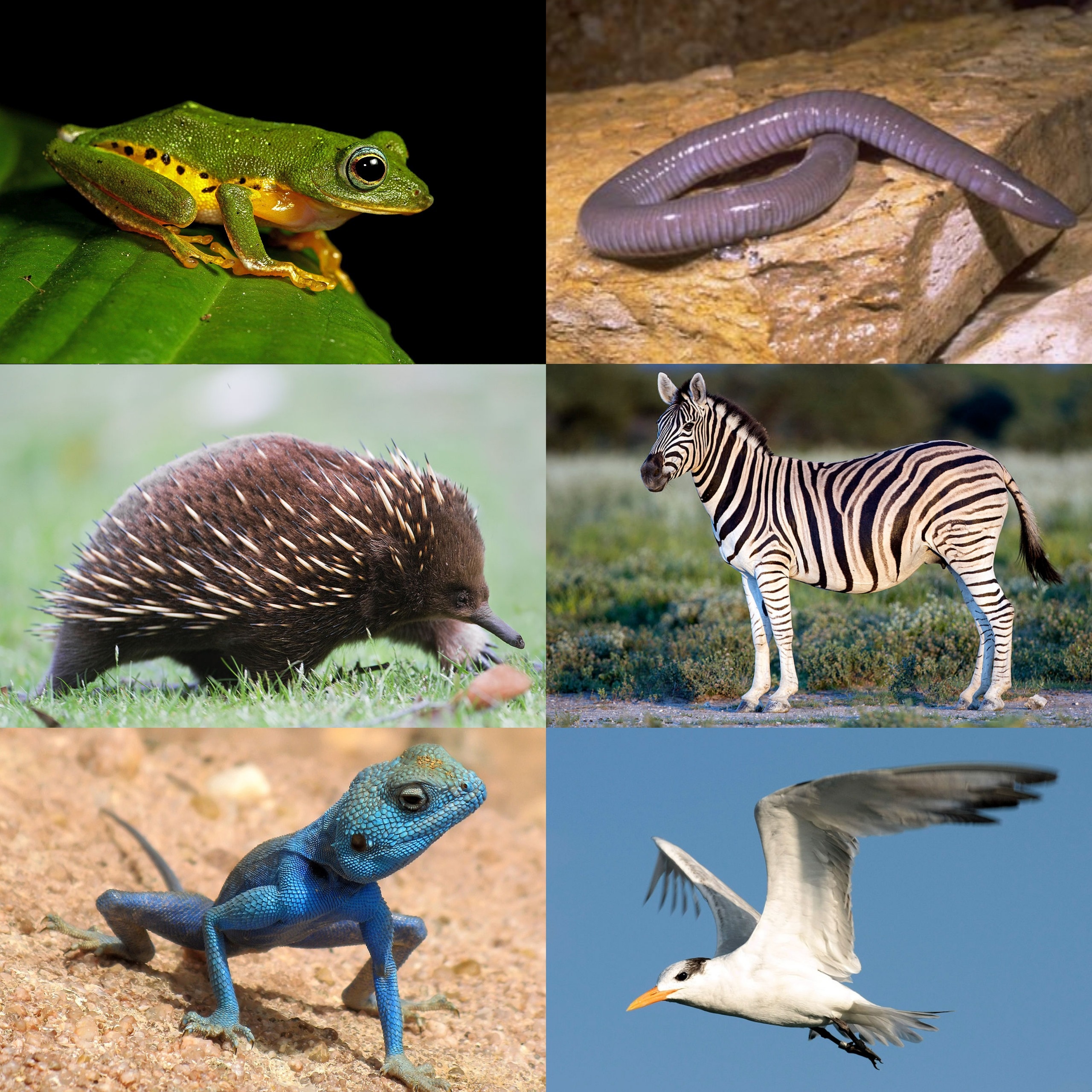
Tetrapod
A tetrapod (/ˈtɛtrəˌpɒd/;[5] from Ancient Greek τετρα- (tetra-) 'four', and πούς (poús) 'foot') is any four-limbed vertebrate animal of the superclass Tetrapoda (/tɛˈtræpədə/).[6] Tetrapods include all extant and extinct amphibians and amniotes, with the latter in turn evolving into two major clades, the sauropsids (reptiles, including dinosaurs and therefore birds) and synapsids (extinct pelycosaurs, therapsids and all extant mammals). Some tetrapods such as snakes, legless lizards, and caecilians had evolved to become limbless via mutations of the Hox gene,[7] although some do still have a pair of vestigial spurs that are remnants of the hindlimbs.
This article is about four-legged vertebrates. For other uses, see Tetrapod (disambiguation).
Tetrapods evolved from a group of primitive semiaquatic animals known as the Tetrapodomorpha which, in turn, evolved from ancient lobe-finned fish (sarcopterygians) around 390 million years ago in the Middle Devonian period;[8] their forms were transitional between lobe-finned fishes and true four-limbed tetrapods. Limbed vertebrates (tetrapods in the broad sense of the word) are first known from Middle Devonian trackways, and body fossils became common near the end of the Late Devonian but these were all aquatic. The first crown-tetrapods (last common ancestors of extant tetrapods capable of terrestrial locomotion) appeared by the very early Carboniferous, 350 million years ago.[9]
The specific aquatic ancestors of the tetrapods and the process by which they colonized Earth's land after emerging from water remains unclear. The transition from a body plan for gill-based aquatic respiration and tail-propelled aquatic locomotion to one that enables the animal to survive out of water and move around on land is one of the most profound evolutionary changes known.[10][11] Tetrapods have numerous anatomical and physiological features that are distinct from their aquatic fish ancestors. These include distinct head and neck structures for feeding and movements, appendicular skeletons (shoulder and pelvic girdles in particular) for weight bearing and locomotion, more versatile eyes for seeing, middle ears for hearing, and more efficient heart and lungs for oxygen circulation and exchange outside water.
The first tetrapods (stem) or "fishapods" were primarily aquatic. Modern amphibians, which evolved from earlier groups, are generally semiaquatic; the first stages of their lives are as waterborne eggs and fish-like larvae known as tadpoles, and later undergo metamorphosis to grow limbs and become partly terrestrial and partly aquatic. However, most tetrapod species today are amniotes, most of which are terrestrial tetrapods whose branch evolved from earlier tetrapods early in the Late Carboniferous. The key innovation in amniotes over amphibians is the amnion, which enables the eggs to retain their aqueous contents on land, rather than needing to stay in water. (Some amniotes later evolved internal fertilization, although many aquatic species outside the tetrapod tree had evolved such before the tetrapods appeared, e.g. Materpiscis.)
Some tetrapods, such as snakes and caecilians, have lost some or all of their limbs through further speciation and evolution; some have only concealed vestigial bones as a remnant of the limbs of their distant ancestors. Others returned to being amphibious or otherwise living partially or fully aquatic lives, the first during the Carboniferous period,[12] others as recently as the Cenozoic.[13][14]
One group of amniotes diverged into the reptiles, which includes lepidosaurs, dinosaurs (which includes birds), crocodilians, turtles, and extinct relatives; while another group of amniotes diverged into the mammals and their extinct relatives. Amniotes include the tetrapods that further evolved for flight—such as birds from among the dinosaurs, pterosaurs from the archosaurs, and bats from among the mammals.
Cladistics[edit]
Stem group[edit]
Stem tetrapods are all animals more closely related to tetrapods than to lungfish, but excluding the tetrapod crown group. The cladogram below illustrates the relationships of stem-tetrapods. All these lineages are extinct except for Dipnomorpha and Tetrapoda; from Swartz, 2012:[72]